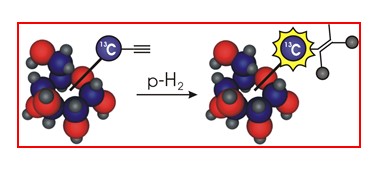Hyperpolarized Probes
Parahydrogen hyperpolarization requires that an unsaturated precursor of the compound of interest can be obtained. The purpose of this research line is the development of new substrates suitable for parahydrogen hyperpolarization. Unsaturated derivatives of metabolites and of biologically relevant molecules are the main focus. The research work aims also to optimize of the parahydrogen-based hyperpolarization procedure.


Among the substrates that have been hyperpolarized by means of the “conventional” parahydrogen approach, i.e. through the addition of the parahydrogen protons to the final product, glucose [Reineri et al. 2010] and choline [Reineri et al. 2012] derivatives must be mentioned.The PHIP-SAH (ParaHydrogen Induced Polarization-Side Arm Hydrogenation) procedure [Reineri et al. 2015] , developed in our laboratory, allows to apply parahydrogen-based hyperpolarization to molecules that cannot be hyperpolarized by means of the addition of parahydrogen protons to the final product. Among these substrates, the most important, from a biological point of view, is pyruvate. Then, acetate and lactate [Cavallari et al. 2017] have been hyperpolarized using this method.